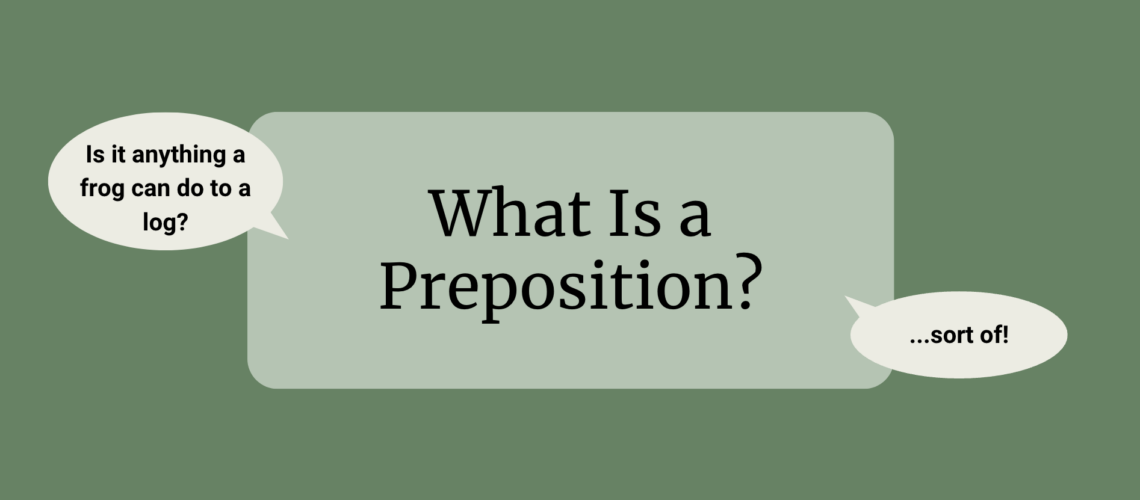What Is a Preposition?
March 15, 2025

“Preposition” is one of those grammar words that seems to be thrown around a lot but never actually clearly explained. Sometimes people seem to (incorrectly) use it as the catch-all: When all the other words in a sentence have been identified—the subjects, verbs, adjectives, etc.—the rest must be the prepositions.
Prepositions don’t have to be mysterious, though! Let’s go through an explanation about what prepositions are with lots of examples to help us out.
Prepositions Defined
Prepositions are one of the eight parts of speech: noun, pronoun, verb, adjective, adverb, conjunction, preposition, and interjection.

Prepositions are all about relationships. They show the relationship that one object or part of a sentence has with another. That relationship might have to do with space, position, time, cause, possession, or any other way that the different elements might be connected.
Merriam Webster gives a pretty good definition: “A preposition is a word—and almost always a very small, very common word—that shows direction, location, or time.” In the sentence “I went to the store,” “to” is the preposition. It’s showing the relationship between me and the store.

Prepositions almost always have objects. These can be nouns, noun phrases, or pronouns. In the sentence “I went to the store,” the object of the preposition is “the store.” (It makes sense that prepositions usually need objects because they need something to connect to! You wouldn’t just say “I went to.” Went to . . . where?)
You might have heard that a preposition is anything that a frog can do to a log (or what a cat can do to a chair, or something else like that):
- The frog can hop outside the log.
- The frog can hop to the log.
- The frog can hop over the log.
- The frog can hide under the log.
- The frog can hide within the log.

However, this doesn’t cover all prepositions. For example, “after” is a preposition, and that’s harder to fit into as sentence about a frog and a log.
Here’s a chart with the most common uses for prepositions and some examples:

With an idea about what a preposition is, it’s time to look at where a preposition can be located within a sentence!
Where Does It Go?
A preposition usually comes before an object. In fact, in Latin, the word “preposition” means “to put before.” A preposition indicates a relationship, so you’ll often find it somewhere between the two elements in the sentence whose relationship it’s describing.
The cat darted under the chair and into the bedroom. (Prepositions: “under” and “into”)
The object of the preposition “under” is “the chair,” and the object of “into” is “the bedroom.”
However, some prepositions come after their objects. The Chicago Manual of Style points out that “that” usually comes after its object:
This is the moment that I’ve been waiting for.
“That” is referring to “the moment,” but it’s located after that noun.
Many grammarians will tell you that a preposition can go just about anywhere in a sentence EXCEPT at the end. Prepositions at the end of sentences can be called terminal prepositions, and lots of people hate them.
He’s the only person I just can’t put up with.
I asked them, “What are you talking about?”
I highlighted those in orange because sentences like that will probably earn you a red mark from your English teacher, but they’re not actually technically wrong. Even though the word “preposition” means “to put before,” in actual English usage, we use prepositions at the ends of sentences all the time.
Learn more about terminal prepositions here!
Examples
Here’s a list of some common prepositions in English (the first nine—which are bolded—are the most common):
- at
- by
- for
- from
- in
- of
- on
- to
- with
- about
- above
- across
- after
- against
- along
- among
- around
- because of
- before
- behind
- below
- beneath
- beside
- between
- close to
- down
- during
- except
- inside
- instead of
- into
- like
- near
- off
- on top of
- onto
- out of
- outside
- over
- past
- since
- through
- toward
- under
- until
- up
- upon
- within
- without
What questions do you have about prepositions? Let me know in the comments!
Click here to learn 6 essential grammar words you should know!
Sources:
- “America’s Most Trusted Dictionary.” Merriam-Webster. Accessed September 10th, 2024. https://www.merriam-webster.com/.
- The Chicago Manual of Style. 17th ed. Chicago, IL: The University of Chicago Press, 2017.
- Einsohn, Amy. The Copyeditor’s Handbook. 3rd ed. Berkeley and Los Angeles, California: Univ of California Pr, 2011.
- Hale, Constance. Sin and Syntax: How To Craft Wicked Good Prose. New York: Three Rivers Press, 2013.
- Merriam-Webster. Merriam-Webster’s Dictionary of English Usage. 14th ed. Taunton, MA: QuadGraphics, 2016.
